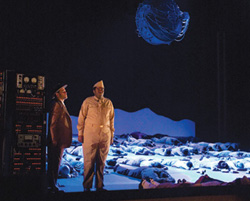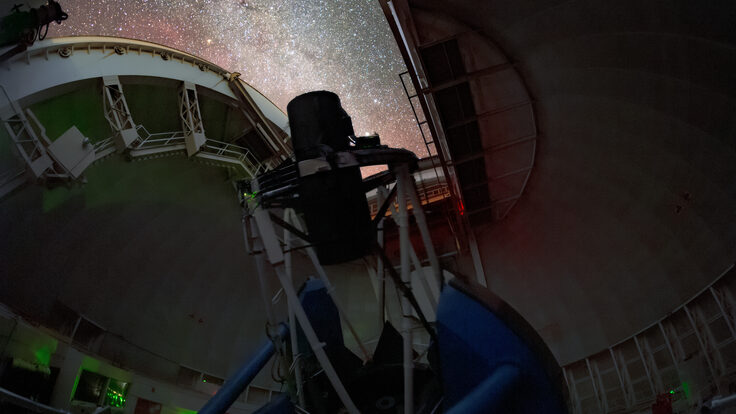Doctor Atomic: A Manhattan Project opera
Particle physics has been getting its due in the theater world with the recent plays Copenhagen and QED, which celebrate the lives and work of famous physicists. Now the field is being paid the highest musical and artistic compliment, inspiring the new opera Doctor Atomic, which had its première in early October by San Francisco Opera. It tells the story of the Manhattan Project, boiling the action down to a few weeks and hours before the test of the first atomic bomb in April 1945. The opera centers on science director and physicist J. Robert Oppenheimer, his wife Kitty, Edward Teller, General Leslie Groves, and the young idealistic scientist, Robert Wilson. Pulitzer-prize winning composer John Adams wrote the music and his long-time collaborator Peter Sellars directed the opera and cobbled together the libretto from declassified government documents, personal letters, interviews with project participants, and Oppenheimer's favorite poetry. As a science writer at the Exploratorium, I became involved in this production when the museum was asked by San Francisco Opera to create a companion Web site for the opera, focusing on the scientific, cultural, and historical impact of the atomic bomb. My museum has a stake in the story: physicist Frank Oppenheimer, who founded the Exploratorium in 1969, was the younger brother of J. Robert, and worked alongside him on the Manhattan Project. So it was with great anticipation that I attended the opera's première, wondering how the celebrated creators of Doctor Atomic would handle such a complex, momentous event in our nation's history. For the most part, I wasn't disappointed. It was a musically thrilling, intellectually challenging, and deeply affecting three hours with only a few fizzles. John Adams uses a full palate of musical devices, from electronic compositions that evoke industrial mayhem, to tender passionate duets between Robert and Kitty, to clashing chords and tympani that pulled me to the edge of my seat. The orchestral music was at times full of tension and menace, foreshadowing the bomb detonation and its consequences. At other times, it provided quiet interludes, where the audience could contemplate the legacy of this ultimate weapon of mass destruction. In one of the most gorgeous passages at the end of Act 1, Oppenheimer is alone with his creation, known by scientists as "the gadget," singing the words of the John Donne sonnet, "Trinity" (for which the bomb test was named): "Batter my heart, three-person'd God." After fending off his fellow scientists' moral objections to the bomb's use against Japan, he surrenders a moment to his own Faustian misgivings. The libretto was both intriguing and risky. Since Peter Sellars pieced it together from disparate sources and compressed the story into a very short time period, people not familiar with the science or history of the Manhattan Project may feel dropped into the middle of the action with precious little character or plot development. The dialog between physicists was often dense, as when Teller reports that Enrico Fermi was taking bets on whether the bomb test would ignite Earth's atmosphere in a vast "chain reaction." (This was an erroneous bit of physics since the question was whether heat from the blast would ignite a thermonuclear fusion reaction, not a fission chain reaction.) For background, it helped to attend the pre-opera lecture and I appreciated that Adams and Sellars never talked down to the audience but assumed we would come to the material with our own knowledge, background, and thoughts about atomic weapons and their use. Of course, the opera's dramatic and anticipated high point comes at the end: the bomb goes off. In this age of special effects, Adams and Sellars were subtle. The countdown to the Trinity test stretched out with the orchestra driving relentlessly forward and the chorus shriek- singing words from theBhagavad Gita: "I am become Death, the destroyer of worlds." Then all goes quiet, we see the greenish glow of a distant explosion on the faces of the chorus, and then hear the soft voice of a Japanese woman asking for a drink of watertaped testimony from a Hiroshima survivor. Thus, the opera ushers in a new age.
Explore more of Doctor Atomic at www.exploratorium.edu/doctoratomic |
||
Click here to download the pdf version of this article.







